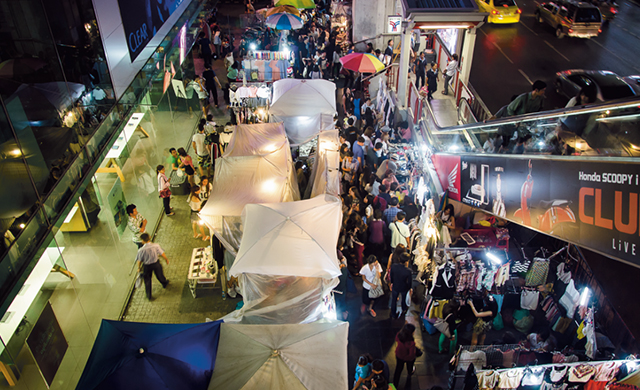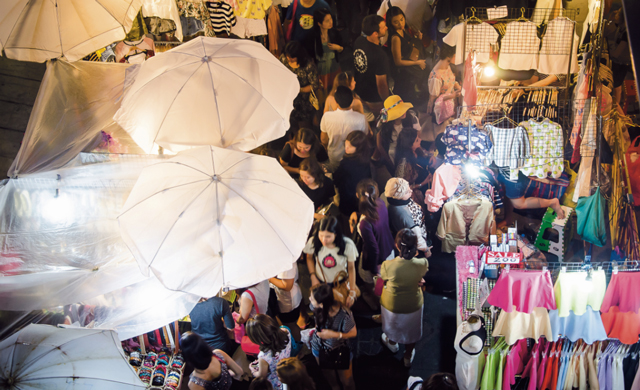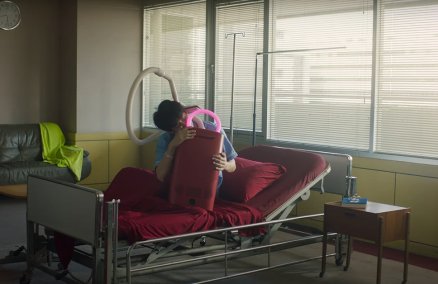Watcharathit, 26, is a journalist for Now channel. He founded the Facebook page Saynostall to give members of the public a platform to share their complaints about Bangkok’s walkways. His vitriolic mission statement is “To claim footpaths back for pedestrians … and condemn street vendors and those who support them.” In little over a year, the page has gathered over 5,000 followers.
What do your page followers mostly complain about?
Footpaths being blocked by stall vendors operating in unpermitted areas, and vendors who work during the daytime. In some instances, these vendors have turned violent, and have left some furious posts on my page. I think we need to understand that the problem is not going to be 100-percent fixed overnight, but we can at least start moving in the right direction.
How useful do you think social media is for effecting change?
Social media is a strong communication tool, especially when used to highlight the infringement of people’s rights. It reflects the views of the general public, and gives them a platform to speak out.
What do you personally think about Bangkok’s footpaths?
They’ve been overrun with vendors. And their construction also needs to be improved. They should be smoother and more organized. Some of my page followers have experienced tragic accidents from being forced to walk on the road. Some have reported reaching compromises with the police or municipal officials who don’t want to infringe on the rights of vendors. What rights do other members of the public have?
" In some instances, these vendors have turned violent "
What are your thoughts on the rights of vendors?
I don’t believe that footpath vendors are so poor. For example, in the Boe Bae area, the monthly revenue is estimated at B1.8 billion. Also, vendors are not always paying local authorities to use the space, but rather mafias.
What do you say to the argument that street food is both cheap and popular, and so exists for public demand?
I don’t think street food is cheaper than food courts or canteens, and the food from canteens is prepared in more hygienic conditions. The only reason some footpath vendors can sell at a cheaper price is because they don’t pay taxes. Singapore used to have the same problem with street vendors before they created hawker markets, where people on small budgets can sell food.
Do you have a message for the BMA?
You are now doing the right thing, but it should have started long ago. I’d like the BMA to carry on doing what they’re doing, but be strict about it. Interview by Gail Piyanan
View from the Street
Vendors have their say about tighter controls on curbside retailing.
Kirana Krengwong, 29, shoe vendor, Siam Square
What do you think about tighter measures over commercial trade on Bangkok’s sidewalks?
I want the BMA to understand vendors’ needs. Yes, the footpaths need to be organized, kept clean and safe, but our stalls are also popular. A lot of foreigners come to this area to buy our products.
X Werachai, 31, phone accessories vendor, Siam Square
Do you have a message for the BMA about vendors’ needs?
Organize the stalls, but please don’t kick us out. We can resize and restructure, but to start from scratch would be very difficult. It would take years to regain customers.

Dr. Vallop Suwandee
Chairman of Advisors to Governor of Bangkok
As the chairman of the governor of Bangkok’s advisory committee, Dr. Vallop Suwandee is key to shaping the city’s policy. Sidewalk vendors are currently a top priority for the BMA.
Why has the issue of Bangkok’s street vendors become a priority now?
Actually, the BMA has been working to organize street vendors for a while now, but admittedly, a considerable number of personnel were deployed to deal with the more critical incidents of political demonstrations and flooding. But since the beginning of his second term, Governor Sukhumband Paribatra has implemented various successful measures in problem areas. One example is around Khlong Lod, where a large number of vendors defy laws on cleanliness and orderliness by building shelters on the footpaths and even discarding rubbish in the canal.
Why has the problem of commercial use of sidewalk space been allowed to persist for so long?
Negligence of duties among BMA officials. Some officers at several government offices as well as certain police officers could be cited as factors. Secondly, an insufficient BMA task force has also aggravated the problem. An estimated 80 percent of Bangkok’s street vendors come from rural areas to make their living here after the end of harvest season. They move to Bangkok to sell food on footpaths, or seek employment with other stall owners. A lack of public accountability could also be regarded as a cause. Patrons of street vendors are also part of the problem—we believe that without any buyers, street vendors’ businesses could not survive.
" One of the vendors even admitted to being a government officer "
To what extent does organized crime control commercial use of public footpaths?
It might very well be mentioned that several street-vending areas have been under the control of influential persons. BMA has found that they have claimed ownership of footpaths in several parts of the city and thus rent them out illegally. At a recent meeting of street vendors on Phahon Yothin Road and Khampaeng Petch 1 Road, near Chatuchak Market, called for by the BMA, one of the vendors even admitted to being a government officer with the rank C-9 [the highest rank possible is C-11]. BMA does not possess any power to take legal action against such influential people, but can work closely and share information with the police.

Bundit Pradubsuk
Chairman of ASA’s Security Architecture Committee
Jaidee project (“Friendly Intersection”), a collaboration between ASA’s Security Architecture Committee and the Thai Health Promotion Foundation (ThaiHealth). They intend to develop a 400-meter area including Ratchaprasong and Chit Lom roads using the principals of universal design: environmentally sustainable development that aims to benefit people of all ages, taking into account all manner of physical disability.
How do you identify the problems and what can be done to fix them?
At first, we observe the area in which we aim to run the project to highlight anything capable of causing accidents to passers-by. For example, some sidewalks might be bumpy or difficult to walk on, even impassable for those in wheelchairs. Advertising billboards, phone boxes and local stalls all have the potential to lead to accidents which can be avoided by applying universal design principals.
How far advanced are your plans for Ratchaprasong and Chit Lom?
We submitted our plans to the BMA about two months ago. Now we need to wait and see.
Who would sponsor this development?
According to our plan, the BMA will sponsor it. However, street vendors may need to split the cost of future maintenance. The idea is that, when the area improves, more tourists and customers will be attracted to go there, which in turn becomes beneficial for the vendors.
Have you seen universal design gain much momentum in Bangkok?
Universal design arrived in Thailand about 10 years ago, and gradually it’s becoming more and more recognizable. My team and I are currently in the process of getting universal design added to the curriculum of certain Thai university courses. Interview by Gail Piyanan
View from the Street
What the public think about about Bangkok’s footpaths.
Nut Yodsawat, 22, Business Management student, University of the Thai Chamber of Commerce
Do you like the food stalls on Bangkok’s footpaths?
Yeah, I buy street food almost every day. It’s quick, prices are cheap, and it often tastes better than food from food courts. Also, the Thai minimum wage is pretty low; buying food from food courts everyday seems impossible.
Ahbun Samanchon, 34, co-host of Witcast podcast
What do you think about the state of Bangkok’s footpaths?
They should be for people who walk on foot, but now even motorcyclists use them to beat traffic jams.
























